Web Smarts - Business Savvy
We’ve been building websites since 1998
We are trusted advisors to Over 50 Active Clients within several industries including associations and nonprofits, healthcare, financial services, retail, B2B and more.

We Are
Trusted
Partners
After we deliver a quality website on time and within your budget, we will be there for when it really counts. We will be proactive, consultative and strategic after we launch your website.

We Are
Integration
Experts
We’ve integrated with virtually every AMS system on the market as well as most LMS, publication, advocacy and career center applications. Our company was founded on custom development.

We build websites that are easy to edit, manage and design using the best content management system on the market, Sitefinity CMS.
We Provide A Full Spectrum Of Services
Our Clients Are Our Partners....
John Wurm

The team at Vanguard helped us think about our digital presence from the perspective and needs of our users, while holding true to the values our organization espouses.
Connect With Us
Improve Your Webcopy

The
Vanguard View
Technology articles about one topic from the perspective of Leadership, Marketing and IT professionals .
Think about the tools you use: Keyboards
A carpenter uses a hammer. A chef uses a knife. An artist uses a pencil. And, especially if you've been working from home for the last year (happy quarantine anniversary!) you've likely, for many hours a day, been typing on a keyboard.
A few weeks back we talked about the role that your desk setup and your peripherals play in your day-to-day job. Today we want to dive a little bit deeper into one of the most important pieces of your work setup—your keyboard.
What goes into a keyboard?
Generally, the main parts of the keyboard are as follows:
- PCB (Printed Circuit Board) - The part that connects the switches to your PC.
- Switches - The part that you press that tells the PCB to tell your PC what Key you pressed.
- Plate - What your switches fit in to keep them in place. Not all keyboards use this.
- Keycaps - What goes on top of the switches to let you know what you're pressing - assuming that no one has switched them around. (ex “A”, “Shift”, “4”).
- Case - What everything fits into or onto.
Though there are other parts (some optional or not) like stabilizers, foam, and different ways to mount these parts in or on top of a case, the aforementioned parts are generally what you'll find if you were to... you know:

GIF from: https://tenor.com/view/panda-rage-keyboard-smash-gif-12886788
But what is most important for us at home?
For each part listed above, I could probably write a series of blog posts - but to keep things to the point and relatively self-contained, for those of us working at home, one of the most important things for our health and comfort as we work long hours pressing down on pieces of plastic is:
- The switches of the keyboard
- The layout/size of the keyboard
Let's start first with the layout of the keyboard.
If you're using a laptop keyboard, or even something you consider to be a "normal" keyboard, and you're reading this from the United States, you likely have a staggered, ANSI layout.
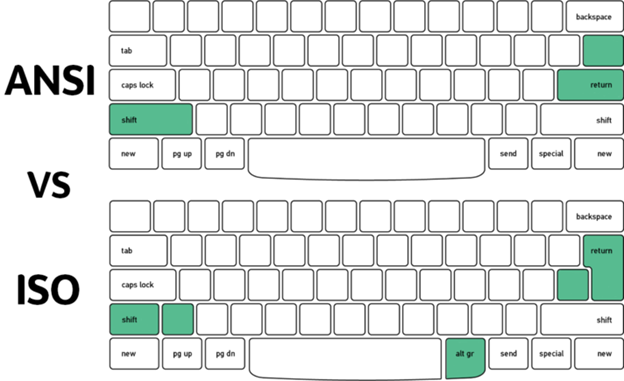
Image from: https://hakukeyboards.com/blogs/mechanical-keyboards/keyboard-layouts-simplified-ansi-vs-iso
Staggered means that your keys are spaced in a way that they are, well, staggered, and not set up in a grid like an ortholinear layout. Ortholinear layouts have been touted as being better for finger and hand health, as every key in an ortholinear layout is spaced/arranged in order to be easy to reach. That said, a large majority of the typing world is very used to staggered layouts.
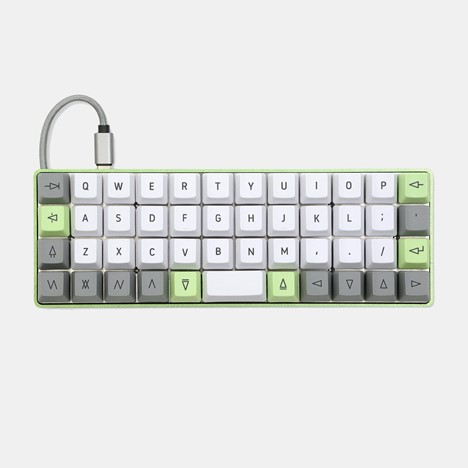
The Planck is a very popular Ortholinear Keyboard. Image from: https://drop.com/buy/planck-mechanical-keyboard
The ANSI layout means that your Enter key is a wide rectangle as opposed to an "upside-down L" shape. ISO layouts also give you two extra keys that are usually symbols frequently used and found in the EU.
When it comes to keyboard sizes, the most common options are Full-Sized (100%), Tenkeyless (80%), and Compact (60%). If you're using a laptop, oftentimes they utilize a 65% style layout. The layout you pick is mostly up to what you need to accomplish, and what best fits your preference. For example, the person currently writing this blog post uses a 40% keyboard.
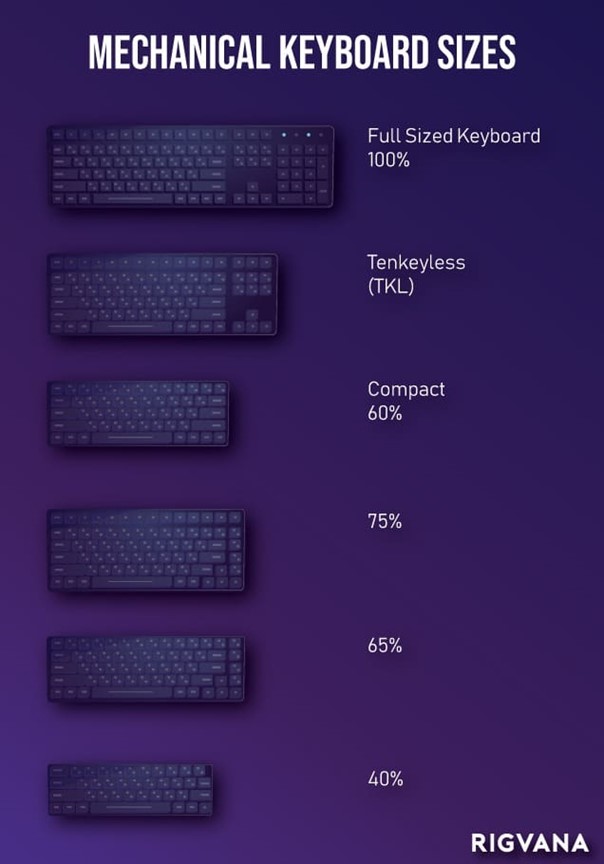
Image from: https://rigvana.com/mechanical-keyboard-size-layout-differences-explained/
If you need to do data entry, it's likely that you'll need a full-sized keyboard with a numpad. If you need to travel with your board, maybe you'll be using a 65% or lower.
Additionally, the size and layout of the keyboard can affect how you position your hands and body while working and is something to consider for the health of your wrists.
Wider boards will require your hands and arms to be further apart, whereas boards with unique layouts can give you more options like the following examples:
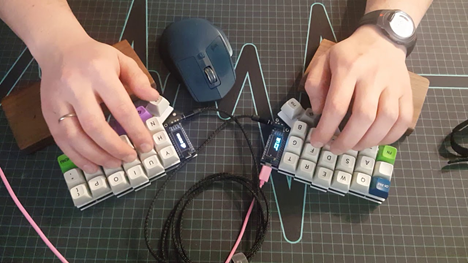
Screenshot from: https://www.youtube.com/watch?v=AMTcQjcTfz0&ab_channel=dvsn-
Split keyboards like the Corne can help you position and angle your hands on your desk with much more flexibility than a normal keyboard.
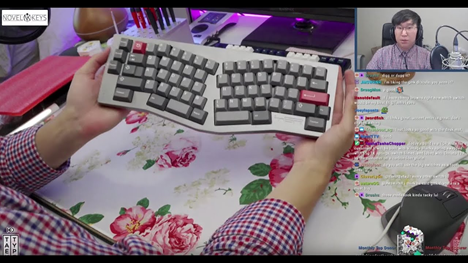
Screenshot from: https://www.youtube.com/watch?v=Gvx14ijrqbw
"Alice" style keyboards also allow you to angle your hands inward for better posture.
The second most important part of a keyboard for a casual user has to do with the switches in the board.
You may have heard the jokes about mechanical keyboards being very loud and annoying at the workplace. This stereotype definitely deserves some merit, but the switches you use in a keyboard can not only change the auditory experience you have, but the tactile experience. This latter experience is incredibly important to the health of your hands and your joints. With this, here are some of the different switches you should think about having in your keyboard for both an auditory and a tactile experience.
Clicky Switches
We'll start with the most notorious of all switches. Clicky switches often have a bump (in varying weight) when pressing down, and make a loud clicking noise depending on the weight of the click bar or the click jacket. If you like feeling a bump as you type, hearing a satisfying click, and don't have to worry about those around you, "clickies" might be a fun switch to try out. Listen here:
Tactile Switches
Tactile switches also have a bump and make a noise - but instead of a click, you're more likely to hear a "thock " or a "tic-tac. " Listen here:
Linear Switches
Linear switches have no "bump" as you press down on them, The noise that you hear when you type using "linears" is the sound of the switch bottoming out. Linear switches are recommended for people who need the lowest resistance when typing, and are generally regarded as being helpful especially for those who may have repetitive strain injury (RSI) or Carpal Tunnel. Listen here:
Topre
Topre is a unique switch that combines a spring and a rubber dome to create a unique experience similar to tactile switches, but a bit more "bubbly " or rounded. Listen here:
Switch Weight
Something to consider, too, is the weight of switches. Most stock switches require 45 grams of force to press down on (sounds a lot heavier than it is) but there are switches that are lighter, or heavier, depending on your preference and your health.
Silenced/Non-Silenced
With the exception of clicky switches, topre, linear, and tactile switches all have silent variations. These are especially helpful if you are working around others, prefer quieter typing noises, or maybe if you even have to work while keeping a baby asleep.
The world (and hobby) of keyboards is incredibly vast and fun to jump into. Even if you don't lube your switches, band-aid mod your stabs, include plate and case foam (yes, we are aware that this probably sounds very foreign) there are still ways to create a typing experience that fits you, your health, and your enjoyment. If you work for hours and hours pressing down on keys - why not make sure that you're treating your fingers, ears, and hands well?
If you are interested in learning more about keyboards, several of our Vanguard staff have custom built their own and would be happy to answer any questions you might have!
Vanguard Tips & Tricks
We provide helpful hints you never knew you needed for our clients. Check out "Vanguard Tips & Tricks" to learn quick and simple hacks to make managing your website easier than ever.
Think about the tools you use: Keyboards
A carpenter uses a hammer. A chef uses a knife. An artist uses a pencil. And, especially if you've been working from home for the last year (happy quarantine anniversary!) you've likely, for many hours a day, been typing on a keyboard.
A few weeks back we talked about the role that your desk setup and your peripherals play in your day-to-day job. Today we want to dive a little bit deeper into one of the most important pieces of your work setup—your keyboard.
What goes into a keyboard?
Generally, the main parts of the keyboard are as follows:
- PCB (Printed Circuit Board) - The part that connects the switches to your PC.
- Switches - The part that you press that tells the PCB to tell your PC what Key you pressed.
- Plate - What your switches fit in to keep them in place. Not all keyboards use this.
- Keycaps - What goes on top of the switches to let you know what you're pressing - assuming that no one has switched them around. (ex “A”, “Shift”, “4”).
- Case - What everything fits into or onto.
Though there are other parts (some optional or not) like stabilizers, foam, and different ways to mount these parts in or on top of a case, the aforementioned parts are generally what you'll find if you were to... you know:

GIF from: https://tenor.com/view/panda-rage-keyboard-smash-gif-12886788
But what is most important for us at home?
For each part listed above, I could probably write a series of blog posts - but to keep things to the point and relatively self-contained, for those of us working at home, one of the most important things for our health and comfort as we work long hours pressing down on pieces of plastic is:
- The switches of the keyboard
- The layout/size of the keyboard
Let's start first with the layout of the keyboard.
If you're using a laptop keyboard, or even something you consider to be a "normal" keyboard, and you're reading this from the United States, you likely have a staggered, ANSI layout.

Image from: https://hakukeyboards.com/blogs/mechanical-keyboards/keyboard-layouts-simplified-ansi-vs-iso
Staggered means that your keys are spaced in a way that they are, well, staggered, and not set up in a grid like an ortholinear layout. Ortholinear layouts have been touted as being better for finger and hand health, as every key in an ortholinear layout is spaced/arranged in order to be easy to reach. That said, a large majority of the typing world is very used to staggered layouts.

The Planck is a very popular Ortholinear Keyboard. Image from: https://drop.com/buy/planck-mechanical-keyboard
The ANSI layout means that your Enter key is a wide rectangle as opposed to an "upside-down L" shape. ISO layouts also give you two extra keys that are usually symbols frequently used and found in the EU.
When it comes to keyboard sizes, the most common options are Full-Sized (100%), Tenkeyless (80%), and Compact (60%). If you're using a laptop, oftentimes they utilize a 65% style layout. The layout you pick is mostly up to what you need to accomplish, and what best fits your preference. For example, the person currently writing this blog post uses a 40% keyboard.

Image from: https://rigvana.com/mechanical-keyboard-size-layout-differences-explained/
If you need to do data entry, it's likely that you'll need a full-sized keyboard with a numpad. If you need to travel with your board, maybe you'll be using a 65% or lower.
Additionally, the size and layout of the keyboard can affect how you position your hands and body while working and is something to consider for the health of your wrists.
Wider boards will require your hands and arms to be further apart, whereas boards with unique layouts can give you more options like the following examples:

Screenshot from: https://www.youtube.com/watch?v=AMTcQjcTfz0&ab_channel=dvsn-
Split keyboards like the Corne can help you position and angle your hands on your desk with much more flexibility than a normal keyboard.

Screenshot from: https://www.youtube.com/watch?v=Gvx14ijrqbw
"Alice" style keyboards also allow you to angle your hands inward for better posture.
The second most important part of a keyboard for a casual user has to do with the switches in the board.
You may have heard the jokes about mechanical keyboards being very loud and annoying at the workplace. This stereotype definitely deserves some merit, but the switches you use in a keyboard can not only change the auditory experience you have, but the tactile experience. This latter experience is incredibly important to the health of your hands and your joints. With this, here are some of the different switches you should think about having in your keyboard for both an auditory and a tactile experience.
Clicky Switches
We'll start with the most notorious of all switches. Clicky switches often have a bump (in varying weight) when pressing down, and make a loud clicking noise depending on the weight of the click bar or the click jacket. If you like feeling a bump as you type, hearing a satisfying click, and don't have to worry about those around you, "clickies" might be a fun switch to try out. Listen here:
Tactile Switches
Tactile switches also have a bump and make a noise - but instead of a click, you're more likely to hear a "thock " or a "tic-tac. " Listen here:
Linear Switches
Linear switches have no "bump" as you press down on them, The noise that you hear when you type using "linears" is the sound of the switch bottoming out. Linear switches are recommended for people who need the lowest resistance when typing, and are generally regarded as being helpful especially for those who may have repetitive strain injury (RSI) or Carpal Tunnel. Listen here:
Topre
Topre is a unique switch that combines a spring and a rubber dome to create a unique experience similar to tactile switches, but a bit more "bubbly " or rounded. Listen here:
Switch Weight
Something to consider, too, is the weight of switches. Most stock switches require 45 grams of force to press down on (sounds a lot heavier than it is) but there are switches that are lighter, or heavier, depending on your preference and your health.
Silenced/Non-Silenced
With the exception of clicky switches, topre, linear, and tactile switches all have silent variations. These are especially helpful if you are working around others, prefer quieter typing noises, or maybe if you even have to work while keeping a baby asleep.
The world (and hobby) of keyboards is incredibly vast and fun to jump into. Even if you don't lube your switches, band-aid mod your stabs, include plate and case foam (yes, we are aware that this probably sounds very foreign) there are still ways to create a typing experience that fits you, your health, and your enjoyment. If you work for hours and hours pressing down on keys - why not make sure that you're treating your fingers, ears, and hands well?
If you are interested in learning more about keyboards, several of our Vanguard staff have custom built their own and would be happy to answer any questions you might have!
Case Studies
Vanguard conducts thorough preliminary investigative work to ensure your website is built to cater specifically to your target audience and meet your organization’s goals. Check out some of the case studies on some of our most recent client success stories.
What Can Vanguard Do For You?
As your organization grows and evolves, your website should as well. Whether you are looking to generate more traffic, implement custom functionality, mobile compatibility, integrate your systems, or give your site a complete redesign, Vanguard Technology is your go-to web partner. Reach out to us with your current concerns with your website, and our experts will happily provide a solution.










Leave a commentOrder by
Newest on top Oldest on top